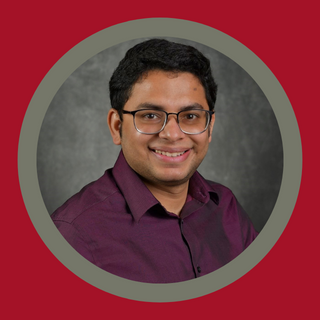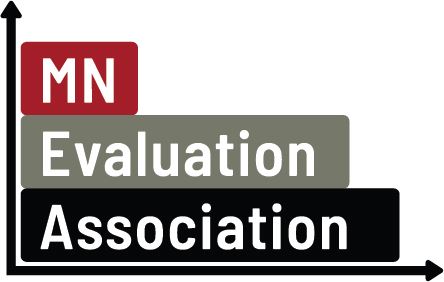Connect. Learn. Community. |
Member Spotlight
The Minnesota Evaluation Association is your local evaluation community committed to increasing evaluation efficacy and spreading the joy of evaluation practice. To lift up members of this community, we've created a series of member spotlights so we can share and benefit from each other's knowledge and wisdom. Check out member spotlights every month-ish!
To nominate someone you know to be spotlit, please email us at info@mneval.org. Make sure to update your membership profile even if it is not public. We may use member profiles to select folks to spotlight in the future.
Featured Profile
Posted 2/26/2023
 Nishank Varshney
Nishank Varshney
The next spotlight in our series features University of Minnesota Ph.D. Student, Nishank Varshney. Nishank is expecting to graduate this spring and will be joining the University of Nebraska Medical Center’s Munroe Meyer Institute as an Assistant Professor in Education and Child Development.
We interviewed Nishank about his path to evaluation and hope for the future.
----------------------------------------------------------------------------------------------------------------------------
MNEA: Nishank, thank you for agreeing to chat with us. Let’s hop right into the questions.What is your background and how does it relate to your practice as an evaluator?
Nishank: I was born and brought up in India. While in my 3rd year of pursuing a dual degree in Electronics & Instrumentation Engineering and Mathematics, I realized that while I like these fields, I didn’t want to make them a career. There are so many engineers in India!
I wanted to work on another problem instead and, around then, India was experiencing protests against corruption. The central government around that time had also passed bills on the right to education, employment guarantees, food, and so on. That got me interested in learning about public policy and how we can help people.
I ended up changing directions and focusing my project thesis on an implementation project of the Right to Education Act that provided access to private schools for disadvantaged communities. While the policy had been enacted, only 32 students had been admitted in one large city. I wanted to know why there was such a low uptake.
MNEA: Where did that question take you?
Nishank: I started digging around and learning about the bottlenecks and the application process itself. I learned there was little focus on raising awareness; the criteria for admission was unclear; and the mechanics of availing the policy weren’t clear. I helped document those processes and we started a student group to collaborate with nonprofits to create and implement awareness campaigns. Those efforts led to an increase in enrollment to 600 students in one year.
After graduating and a short stint in the private sector, I decided to return to this project working with my advisor as a research assistant. I looked at implementation in 3 states. Through that fieldwork, the question that came to my mind was that we’re getting these kids into private school and, because of their backgrounds, they weren’t being accepted. It’s supposed to be inclusive education. We didn’t know if we were really helping or harming them. Would they have been better off if they stayed in the government school? That’s what introduced me to evaluation. We have good intentions but are we helping or harming?
MNEA: How did you approach that question?
Nishank: I worked on a study and a survey tool for a longitudinal study to follow the kids with a comparison group. As I was working on this, I realized I had no social science training! I could only take instructions from others or my advisor. That’s when I decided to get further instruction. I applied and was accepted to the Masters in Public Policy program from Humphrey. That’s been my goal since – to learn about methods to help children and families. And how to scale those programs. In 2018, I joined the Ph.D. program there.
MNEA: What are your most proud evaluation accomplishments from your time at the Humphrey School?
Nishank: Over the last 6 years, I worked on a variety of projects through the Human Capital Research Collaborative. I led a cost/benefit study of the Chicago Child Center Program – it’s an early childhood education program – and published it as my first dissertation chapter this summer. Soon after that, I attended a training on benefit-cost analysis at the University of Pennsylvania and, completely to my surprise, the instructor used my paper as I was sitting there in the audience. It was so cool!
MNEA: Oh, my gosh, that’s amazing! That must have been wild. Did the professor know you were going to be there?
Nishank: No! They didn’t. But after the seminar, I went and introduced myself and told them that was my paper.
MNEA: Okay, so based on your experience, what would you say is the most important principle for evaluation practitioners to keep in mind?
Nishank: What I keep in mind the most: what is going to be the use of this evaluation. What’s the purpose? Is it to see how it works, or what works or whether it works? What will we do with the information? What will we do if it doesn’t work?
I’m also very interested in how we can scale up programs that have had a lot of research on their effectiveness. How can we increase the acceptance of those findings?
When we are doing evaluation of community programs people worry about the results being used to shut programs down. We need to convey the importance of the evaluation and be honest about the possibility of different outcomes, especially if a program is doing harm.
MNEA: What has worked for you in that regard? Any tips?
Nishank: It’s important to be reflective of your own work – your positionality. It’s thinking about what organizations you belong to and what impact that might have. The university where I worked in India - The Institute of Management Ahmedabad -is one of the most reputed universities of India. So when I’d say I’m from there, people in the community or public offices would answer my questions. I would get the answers that they would not provide to others, like journalists or social activists. Knowing the privileges that we can get and the door it opens. To reflect on it and use that power to help. Knowing the power of where we are – institutions and power; race; gender; and geographic location. Leverage what privileges you have and be mindful of not misusing them. Balancing the power and working for the people is what I keep in mind.
MNEA: What are your next steps and hopes?
Nishank: I’m teaching program evaluation at the Humphrey School this semester and I am really excited for that class as it is a client-based experiential class. After my Ph.D. I will be joining the University of Nebraska Medical Center’s Munroe Meyer Institute as an Assistant Professor in Education and Child Development, where I will be working on conducting evaluations of early childhood education and community programs.
MNEA: What are your hopes for the future of the field of evaluation (specifically from where you sit in it)?
Nishank: My hopes are that we need more opportunities to grow. There are many programs that can learn from each other. There are great programs in India that the US can learn from and vice versa and of course beyond. There are programs that are doing amazing work for communities. How we can help through evaluation to document these successes for replication and scale. I’d like to find novel programs and help them replicate!
MNEA: What is one evaluation or research resource that you love to geek out on?
Nishank: I don’t have any one resource in mind in particular. I love following networks around evaluation. AEA brings together great resources. I love attending their conferences. I follow people through Twitter. I’ve been recently reading the Better Evaluation website. They also have a lot of resources.Profile Archive


